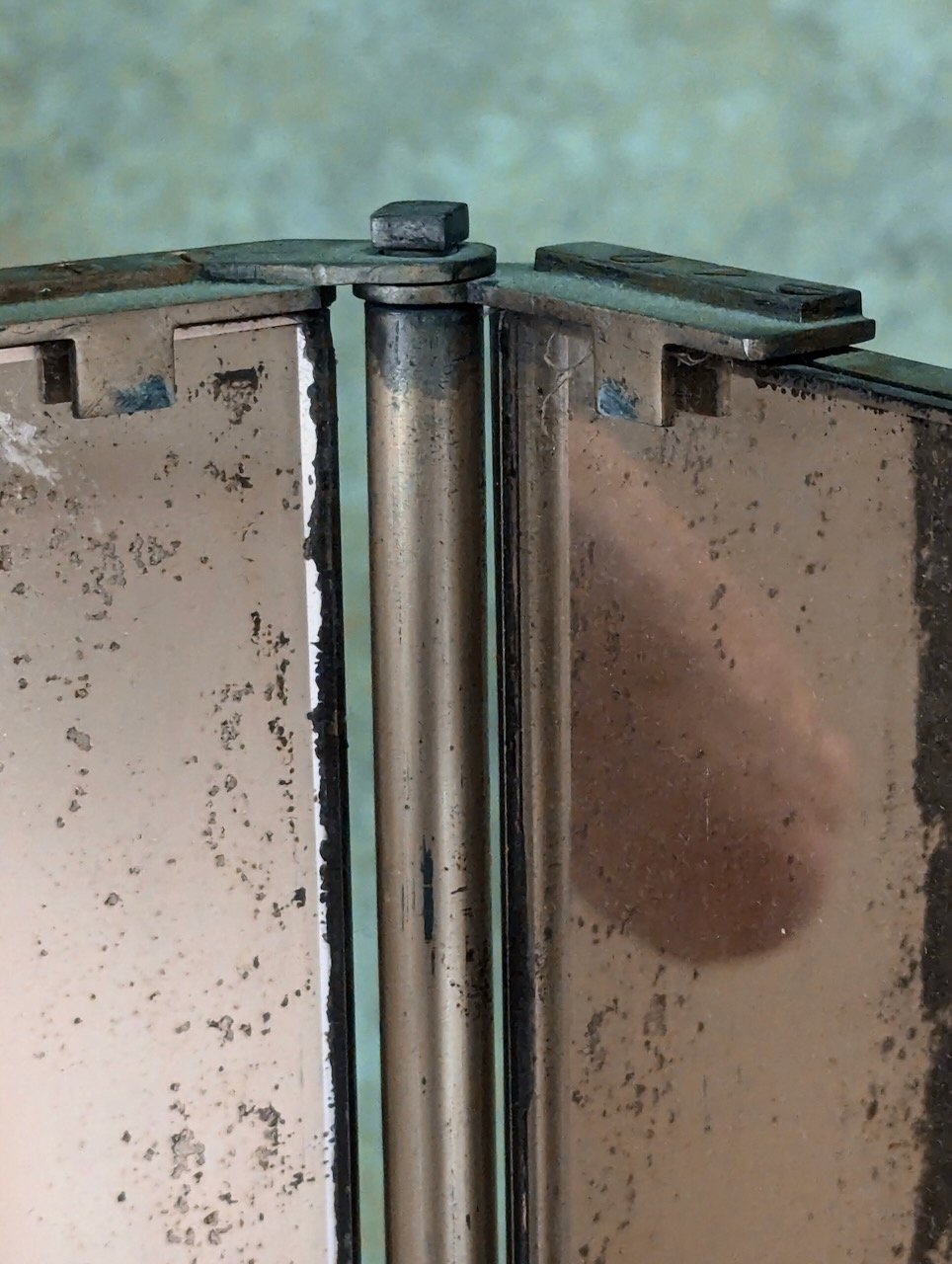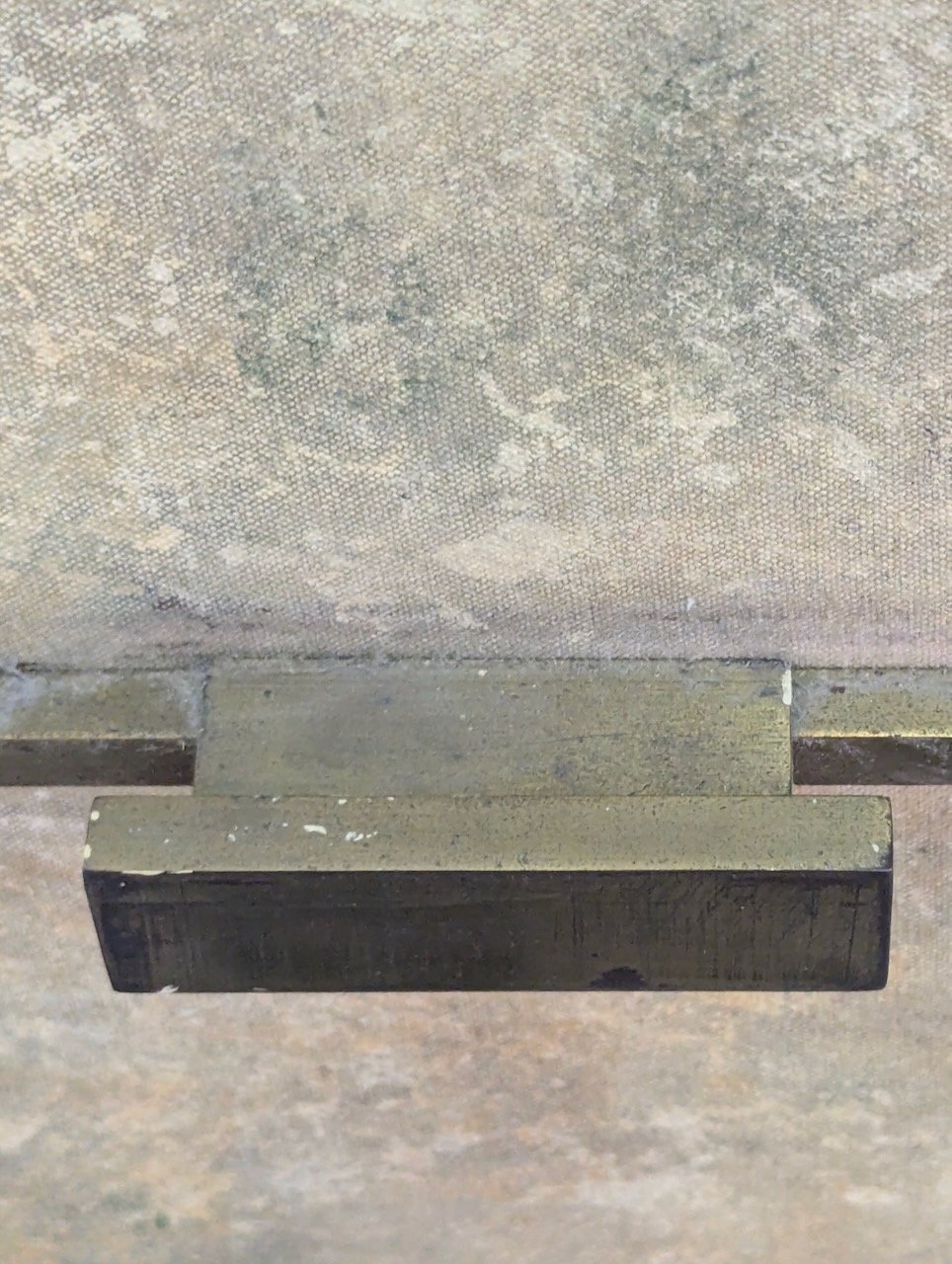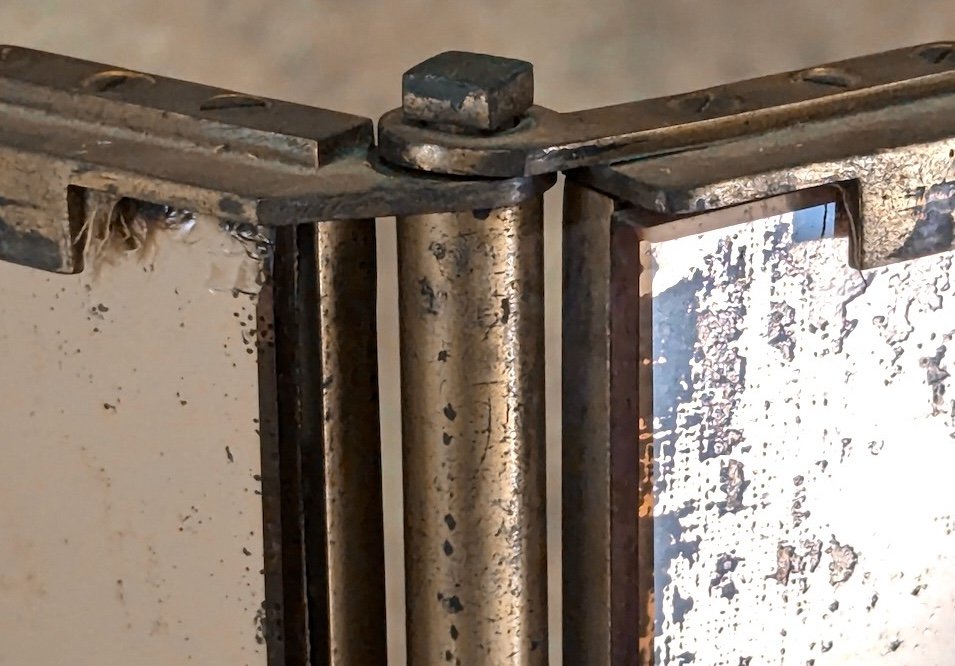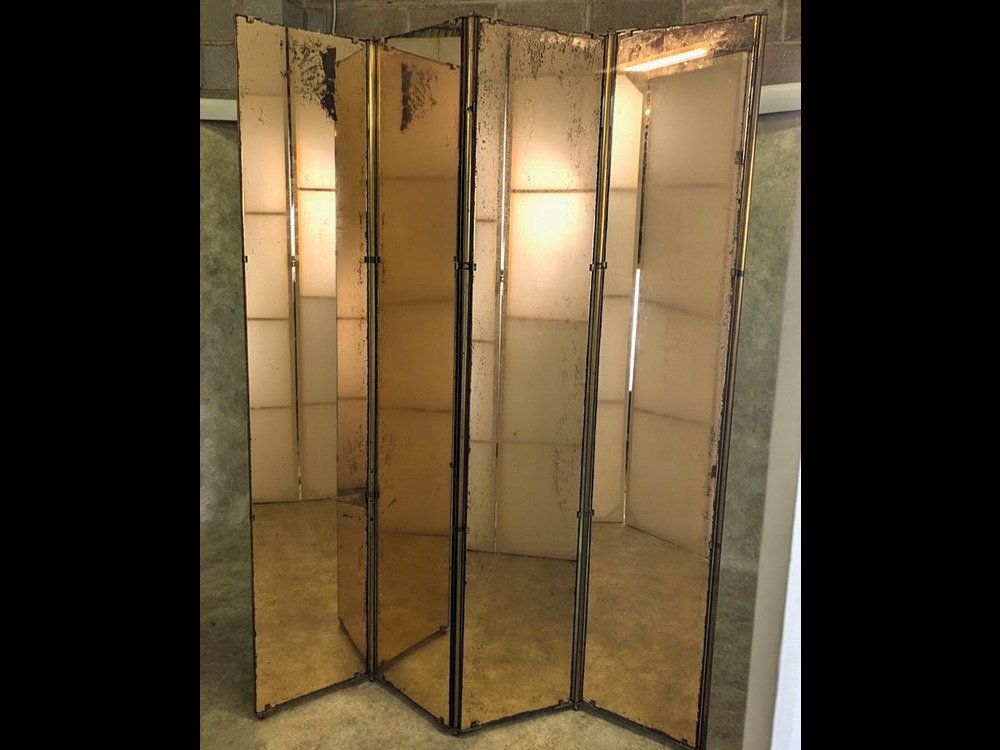Jacques Adnet floor mirror (#1870)
French Modernist Art Deco floor mirror by Jacques Adnet. This four-panel standing mirror has all the original glass. Each panel is 12” wide x 64” high and the mirror is 4’ flat when fully open. Bronze frame.
An icon of luxurious French Modernism,JACQUES ADNET was both an architect and a designer. Adnet was born in 1900 in Chatillon-Colligny (Loiret area), France, and grew up with the 20th Century. He attended the Municipal College of Design in Auxerre and the Ecole des Arts Décoratifs to study architecture under Charles Genuys. In Paris beginning in 1922, he worked for the prestigious designers Henri Rapin and Maurice Dufrene at La Maitrise.
From 1923 he exhibited at the Salon des Artistes Decorateurs, serving as its president at one point in his career.
He exhibited and won numerous awards at the Paris 1925 Exposition Internationale des Arts Décoratifs et Industriels Modernes. Adnet was distinctly avant garde and was among the first of the French modernist designers to expect metal and glass to integrate with the structure and decoration of furniture. He was receptive to all the contributions of an era in full evolution rich as much in materials as in new technological means.
in 1926 he designed the salle commune of the Ile-de-France. By 1928, had become Director of La Compagnie des Arts Français - at the age of 28! Also in 1928 he received the Blumenthal Prize*. And at the 1937 Paris Exhibition he was awarded the Grand Prix d’Architecture for the Pavillon de Saint-Gobains
The chic address of CAF at 116 rue du Faubourg Saint Honoré in Paris, where he stayed until 1959, provided Adnet with an ideal platform from which to promote his modernist designs. These incorporated precious woods, chromed metals, embellishments such as mirror, leather, parchment and smoked glass in linear styles with decoration pared away wherever possible. A 1930 quote summarized the effort: “What a lot of work to achieve simplicity!”
Henri Clouzot, the renowned French filmmaker, wrote of his work: “The art of Jacques Adnet is a happy art.” He knew how to make room for freedom of expression, for fantasy and for furniture that preserved the individuality of his clients.
His installations included the mansion of Frank Jay Gould, the reception room of the Administrator of the College of France, apartment of Alice Cocea, the office of the President of the French Republic in Rambouillet, etc., and the decoration of the oceanliner Ferdinand de Lesseps.
In 1970 Adnet became director of Ecole Nationale Supérieure des Arts Décoratifs. He died in 1984 having created a legacy of fine design that feels “modern” even today.
*The Prix Blumenthal (or Blumenthal Prize) was a grant or stipend awarded through the philanthropy of Florence Meyer Blumenthal (1875–1930) — and the foundation she created, Fondation franco-américaine Florence Blumenthal (Franco-American Florence Blumenthal Foundation) — to discover young French artists, aid them financially, and in the process draw the United States and France closer together through the arts.[1]
Winners were designated by seven juries in the fields of the literature, painting, sculpture, decorative arts, structure, engraving and music — to receive a purse of six thousand francs per year, given for two years. The purse increased in 1926 until Blumenthal's death in 1930 to ten thousand francs for two years.
French Modernist Art Deco floor mirror by Jacques Adnet. This four-panel standing mirror has all the original glass. Each panel is 12” wide x 64” high and the mirror is 4’ flat when fully open. Bronze frame.
An icon of luxurious French Modernism,JACQUES ADNET was both an architect and a designer. Adnet was born in 1900 in Chatillon-Colligny (Loiret area), France, and grew up with the 20th Century. He attended the Municipal College of Design in Auxerre and the Ecole des Arts Décoratifs to study architecture under Charles Genuys. In Paris beginning in 1922, he worked for the prestigious designers Henri Rapin and Maurice Dufrene at La Maitrise.
From 1923 he exhibited at the Salon des Artistes Decorateurs, serving as its president at one point in his career.
He exhibited and won numerous awards at the Paris 1925 Exposition Internationale des Arts Décoratifs et Industriels Modernes. Adnet was distinctly avant garde and was among the first of the French modernist designers to expect metal and glass to integrate with the structure and decoration of furniture. He was receptive to all the contributions of an era in full evolution rich as much in materials as in new technological means.
in 1926 he designed the salle commune of the Ile-de-France. By 1928, had become Director of La Compagnie des Arts Français - at the age of 28! Also in 1928 he received the Blumenthal Prize*. And at the 1937 Paris Exhibition he was awarded the Grand Prix d’Architecture for the Pavillon de Saint-Gobains
The chic address of CAF at 116 rue du Faubourg Saint Honoré in Paris, where he stayed until 1959, provided Adnet with an ideal platform from which to promote his modernist designs. These incorporated precious woods, chromed metals, embellishments such as mirror, leather, parchment and smoked glass in linear styles with decoration pared away wherever possible. A 1930 quote summarized the effort: “What a lot of work to achieve simplicity!”
Henri Clouzot, the renowned French filmmaker, wrote of his work: “The art of Jacques Adnet is a happy art.” He knew how to make room for freedom of expression, for fantasy and for furniture that preserved the individuality of his clients.
His installations included the mansion of Frank Jay Gould, the reception room of the Administrator of the College of France, apartment of Alice Cocea, the office of the President of the French Republic in Rambouillet, etc., and the decoration of the oceanliner Ferdinand de Lesseps.
In 1970 Adnet became director of Ecole Nationale Supérieure des Arts Décoratifs. He died in 1984 having created a legacy of fine design that feels “modern” even today.
*The Prix Blumenthal (or Blumenthal Prize) was a grant or stipend awarded through the philanthropy of Florence Meyer Blumenthal (1875–1930) — and the foundation she created, Fondation franco-américaine Florence Blumenthal (Franco-American Florence Blumenthal Foundation) — to discover young French artists, aid them financially, and in the process draw the United States and France closer together through the arts.[1]
Winners were designated by seven juries in the fields of the literature, painting, sculpture, decorative arts, structure, engraving and music — to receive a purse of six thousand francs per year, given for two years. The purse increased in 1926 until Blumenthal's death in 1930 to ten thousand francs for two years.
French Modernist Art Deco floor mirror by Jacques Adnet. This four-panel standing mirror has all the original glass. Each panel is 12” wide x 64” high and the mirror is 4’ flat when fully open. Bronze frame.
An icon of luxurious French Modernism,JACQUES ADNET was both an architect and a designer. Adnet was born in 1900 in Chatillon-Colligny (Loiret area), France, and grew up with the 20th Century. He attended the Municipal College of Design in Auxerre and the Ecole des Arts Décoratifs to study architecture under Charles Genuys. In Paris beginning in 1922, he worked for the prestigious designers Henri Rapin and Maurice Dufrene at La Maitrise.
From 1923 he exhibited at the Salon des Artistes Decorateurs, serving as its president at one point in his career.
He exhibited and won numerous awards at the Paris 1925 Exposition Internationale des Arts Décoratifs et Industriels Modernes. Adnet was distinctly avant garde and was among the first of the French modernist designers to expect metal and glass to integrate with the structure and decoration of furniture. He was receptive to all the contributions of an era in full evolution rich as much in materials as in new technological means.
in 1926 he designed the salle commune of the Ile-de-France. By 1928, had become Director of La Compagnie des Arts Français - at the age of 28! Also in 1928 he received the Blumenthal Prize*. And at the 1937 Paris Exhibition he was awarded the Grand Prix d’Architecture for the Pavillon de Saint-Gobains
The chic address of CAF at 116 rue du Faubourg Saint Honoré in Paris, where he stayed until 1959, provided Adnet with an ideal platform from which to promote his modernist designs. These incorporated precious woods, chromed metals, embellishments such as mirror, leather, parchment and smoked glass in linear styles with decoration pared away wherever possible. A 1930 quote summarized the effort: “What a lot of work to achieve simplicity!”
Henri Clouzot, the renowned French filmmaker, wrote of his work: “The art of Jacques Adnet is a happy art.” He knew how to make room for freedom of expression, for fantasy and for furniture that preserved the individuality of his clients.
His installations included the mansion of Frank Jay Gould, the reception room of the Administrator of the College of France, apartment of Alice Cocea, the office of the President of the French Republic in Rambouillet, etc., and the decoration of the oceanliner Ferdinand de Lesseps.
In 1970 Adnet became director of Ecole Nationale Supérieure des Arts Décoratifs. He died in 1984 having created a legacy of fine design that feels “modern” even today.
*The Prix Blumenthal (or Blumenthal Prize) was a grant or stipend awarded through the philanthropy of Florence Meyer Blumenthal (1875–1930) — and the foundation she created, Fondation franco-américaine Florence Blumenthal (Franco-American Florence Blumenthal Foundation) — to discover young French artists, aid them financially, and in the process draw the United States and France closer together through the arts.[1]
Winners were designated by seven juries in the fields of the literature, painting, sculpture, decorative arts, structure, engraving and music — to receive a purse of six thousand francs per year, given for two years. The purse increased in 1926 until Blumenthal's death in 1930 to ten thousand francs for two years.





